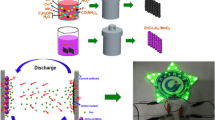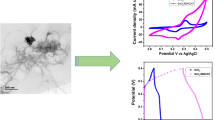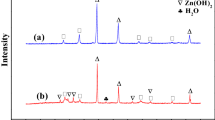Abstract
We reported the sol–gel synthesis for preparing ZnS and SnO2 products and their composite material, for the first time for application as an electrode for a hybrid supercapacitor to attain an optimized energy storage performance. The structural feature reveals that the high phase purity and crystallinity with tetragonal SnO2, and in the cubic crystal structure of ZnS has been successfully verified from XRD analysis. A snow-like morphology of SnO2 and irregular nanoparticles in shape with a honeycomb-like appearance of ZnS and their combination that is detected in the ZnS–SnO2 composite without any residues was noticed on the surface of the samples, which was confirmed from the FESEM study. The electrochemical properties demonstrated that the ZnS–SnO2 composite manifests more awesome performance than its bulk materials, e.g., 466 F/g of capacitance, good rate performance, and reversibility with good charge transport properties. These striking results motivated us to fabricate a hybrid supercapacitor for practical aspects of the as-prepared electrode material. To do so, a ZnS–SnO2||AC/KOH hybrid supercapacitor was fabricated, which delivers a good stability of 85.7% (7000 cycles) and supreme power delivery of 4238.4 W/kg. A great specific energy of 36.12 Wh/kg after adding an optimum voltage of 1.7 V. These outstanding outcomes manifest the promising route to prepare another metal oxide/hydroxide for electrochemical energy conversion and storage devices.








Similar content being viewed by others
Data availability
The data related to this study can be available at a reasonable request from the corresponding author.
References
S.A. Ahmad et al., High power aqueous hybrid asymmetric supercapacitor based on zero-dimensional ZnS nanoparticles with two-dimensional nanoflakes CuSe2 nanostructures. Ceram. Int. 49(12), 20007–20016 (2023)
M. Arif et al., CdS nanoparticles decorated on carbon nanofibers as the first ever utilized as an electrode for advanced energy storage applications. J. Inorg. Organomet. Polym Mater. 33(4), 969–980 (2023)
M.S.U. Shah et al., Nickel selenide nano-cubes anchored on cadmium selenide nanoparticles: first-ever designed as electrode material for advanced hybrid energy storage applications. J. Energy Storage. 63, 107065 (2023)
E. Ullah et al., Hydrothermal assisted synthesis of hierarchical SnO2 micro flowers with CdO nanoparticles based membrane for energy storage applications. Chemosphere 321, 138004 (2023)
M. Sajjad et al., Recent trends in transition metal diselenides (XSe2: X = ni, Mn, Co) and their composites for high energy faradic supercapacitors. J. Energy Storage 43, 103176 (2021)
M. Sajjad et al., A review on selection criteria of aqueous electrolytes performance evaluation for advanced asymmetric supercapacitors. J. Energy Storage. 40, 102729 (2021)
Ã. Sánchez-Sánchez et al., The importance of electrode characterization to assess the supercapacitor performance of ordered mesoporous carbons. Microporous Mesoporous Mater. 235, 1–8 (2016)
V. Velmurugan et al., Synthesis of tin oxide/graphene (SnO2/G) nanocomposite and its electrochemical properties for supercapacitor applications. Mater. Res. Bull. 84, 145–151 (2016)
M.Z.U. Shah et al., A new CuO/TiO2 nanocomposite: an emerging and high energy efficient electrode material for aqueous asymmetric supercapacitors. J. Energy Storage 55, 105492 (2022)
M.Z.U. Shah et al., Copper sulfide nanoparticles on titanium dioxide (TiO2) nanoflakes: a new hybrid asymmetrical faradaic supercapacitors with high energy density and superior lifespan. J. Energy Storage 55, 105651 (2022)
M. Sajjad et al., A novel high-performance all-solid-state asymmetric supercapacitor based on CuSe nanoflakes wrapped on vertically aligned TiO2 nanoplates nanocomposite synthesized via a wet-chemical method. J. Energy Storage 55, 105304 (2022)
B.A. Khan et al., NiSe2 nanocrystals intercalated rGO sheets as a high-performance asymmetric supercapacitor electrode. Ceram. Int. 48(4), 5509–5517 (2022)
J.A. Syed et al., Hierarchical multicomponent electrode with interlaced Ni(OH)2 nanoflakes wrapped zinc cobalt sulfide nanotube arrays for sustainable high-performance supercapacitors. Adv. Energy Mater. 7(22), 1701228 (2017)
C. Zhang et al., All-solid-state asymmetric supercapacitors based on Fe-doped mesoporous Co3O4 and three-dimensional reduced graphene oxide electrodes with high energy and power densities. Nanoscale 9(40), 15423–15433 (2017)
K. Khan et al., Development of 1.6 V hybrid supercapacitor based on ZnO nanorods/MnO2 nanowires for next-generation electrochemical energy storage. J. Electroanal. Chem. 922, 116753 (2022)
M.Z.U. Shah et al., A novel TiO2/CuSe based nanocomposite for high-voltage asymmetric supercapacitors. J. Science: Adv. Mater. Devices 7(2), 100418 (2022)
M.Z.U. Shah et al., Hydrothermal synthesis of ZnO@ ZnS heterostructure on ni foam: a binder free electrode for high power and stable hybrid supercapacitors. Mater. Lett. 326, 132910 (2022)
M. Sajjad, W. Lu, Covalent organic frameworks based nanomaterials: design, synthesis, and current status for supercapacitor applications: a review. J. Energy Storage. 39, 102618 (2021)
M. Sajjad, W. Lu, Honeycomb-based heterostructures: an emerging platform for advanced energy applications: a review on energy systems. Electrochem. Sci. Adv. 2(5), e202100075 (2022)
J. Li et al., Three-dimensional nitrogen and phosphorus co-doped carbon quantum dots/reduced graphene oxide composite aerogels with a hierarchical porous structure as superior electrode materials for supercapacitors. J. Mater. Chem. A 7(46), 26311–26325 (2019)
K. Chen et al., Structural design of graphene for use in electrochemical energy storage devices. Chem. Soc. Rev. 44(17), 6230–6257 (2015)
J. Ismail et al., Comparative capacitive performance of MnSe encapsulated GO based nanocomposites for advanced electrochemical capacitor with rapid charge transport channels. Mater. Chem. Phys. 284, 126059 (2022)
M. Sajjad et al., A new CuSe–TiO2–GO ternary nanocomposite: realizing a high capacitance and voltage for an advanced hybrid supercapacitor. Nanomaterials 13(1), 123 (2022)
Z. Yang et al., Vertically-aligned Mn(OH)2 nanosheet films for flexible all-solid-state electrochemical supercapacitors. J. Mater. Sci. Mater. Electron. 28(23), 17533–17540 (2017)
X. Jia, X. Wu, B.J.D.T. Liu, Formation of ZnCo2O4@ MnO2 core–shell electrode materials for hybrid supercapacitor. Dalton Trans. 47(43), 15506–15511 (2018)
H. Liu et al., Boosting energy storage and electrocatalytic performances by synergizing CoMoO4@ MoZn22 core-shell structures. Chem. Eng. J. 373, 485–492 (2019)
K. Tao et al., A metal–organic framework derived hierarchical nickel–cobalt sulfide nanosheet array on Ni foam with enhanced electrochemical performance for supercapacitors. Dalton Trans. 47(10), 3496–3502 (2018)
X. Han et al., Design of a porous cobalt sulfide nanosheet array on Ni foam from zeolitic imidazolate frameworks as an advanced electrode for supercapacitors. Nanoscale 10(6), 2735–2741 (2018)
G. Yuan et al., Cu/Cu2O nanostructures derived from copper oxalate as high performance electrocatalyst for glucose oxidation. Chin. Chem. Lett. 31(7), 1941–1945 (2020)
T.N. Trindade, L.A.J.J.o.A., Silva, Compounds, Cd-doped SnO2/CdS heterostructures for efficient application in photocatalytic reforming of glycerol to produce hydrogen under visible light irradiation. J. Alloys Compd. 735, 400–408 (2018)
N. Bhardwaj, S.J.C.I. Mohapatra, Structural, optical and gas sensing properties of Ag–SnO2 plasmonic nanocomposite thin films. Ceram. Int. 42(15), 17237–17242 (2016)
S. Ren et al., Hollow SnO2 microspheres and their carbon-coated composites for supercapacitors. Colloids Surf. A: Physicochem. Eng. Asp. 444, 26–32 (2014)
L. Yu et al., Hydrothermal synthesis of SnO2 and SnO2@ C nanorods and their application as anode materials in lithium-ion batteries. RSC Adv. 3(38), 17281–17286 (2013)
B. Saravanakumar et al., Enhanced pseudocapacitive performance of SnO2, ZnS–nO2, and Ag–SnO2 nanoparticles. Ionics 24(12), 4081–4092 (2018)
H. Chen et al., Highly conductive NiCo2 S4 urchin-like nanostructures for high-rate pseudocapacitors. Nanoscale 5(19), 8879–8883 (2013)
Y. Gao et al., Double metal ions synergistic effect in hierarchical multiple sulfide microflowers for enhanced supercapacitor performance. ACS Appl. Mater. Interfaces 7(7), 4311–4319 (2015)
S.A. Ahmad et al., Facile synthesis of hierarchical ZnS@ FeSe2 nanostructures as new energy-efficient cathode material for advanced asymmetric supercapacitors. J. Science: Adv. Mater. Devices 7(4), 100489 (2022)
K. Krishnamoorthy et al., One pot hydrothermal growth of hierarchical nanostructured Ni3S2 on Ni foam for supercapacitor application. Chem. Eng. J. 251, 116–122 (2014)
S. BiBi et al., A new ZnO–ZnS–CdS heterostructure on Ni substrate: a binder-free electrode for advanced asymmetric supercapacitors with improved performance. Electrochim. Acta 430, 141031 (2022)
N.S. Arul, L. Cavalcante, J. In Han, Facile synthesis of ZnS/MnS nanocomposites for supercapacitor applications. J. Solid State Electrochem. 22(1), 303–313 (2018)
R. Ramachandran et al., Solvothermal synthesis of zinc sulfide decorated graphene (ZnS/G) nanocomposites for novel supercapacitor electrodes. Electrochim. Acta 178, 647–657 (2015)
X. Hou et al., Ultrathin ZnS nanosheet/carbon nanotube hybrid electrode for high-performance flexible all-solid-state supercapacitor. Nano Res. 10(8), 2570–2583 (2017)
K. Patel, M. Deshpande, S. Chaki, Doping-induced changes in the structural, optical, magnetic and thermal properties of Ni: ZnS nanoparticles prepared by microwave-assisted chemical method. Appl. Phys. A 127(10), 1–8 (2021)
U. Gawai, B. Dole, Local structural studies on Co doped ZnS nanowires by synchrotron X-ray atomic pair distribution function and micro-raman shift. RSC Adv. 7(59), 37402–37411 (2017)
R. Katiyar et al., Dynamics of the rutile structure. III. Lattice dynamics, infrared and Raman spectra of SnO2. J. Phys. C: Solid State Phys. 4(15), 2421 (1971)
K. Yu et al., Microstructural change of nano-SnO2 grain assemblages with the annealing temperature. Phys. Rev. B 55(4), 2666 (1997)
M. Sajjad et al., Low-temperature synthesis of 3D copper selenide micro-flowers for high-performance supercapacitors. Mater. Lett. 314, 131857 (2022)
M. Sajjad et al., CuCo2O4 nanoparticles wrapped in a rGO aerogel composite as an anode for a fast and stable Li-ion capacitor with ultra-high specific energy. New J. Chem. 45(44), 20751–20764 (2021)
M. Sajjad, Y. Khan, Rational design of self-supported Ni3S2 nanoparticles as a battery type electrode material for high-voltage (1.8 V) symmetric supercapacitor applications. CrystEngComm 23(15), 2869–2879 (2021)
M. Sajjad, R. Tao, L. Qiu, Phosphine based covalent organic framework as an advanced electrode material for electrochemical energy storage. J. Mater. Sci.: Mater. Electron. 32(2), 1602–1615 (2021)
M. Sajjad et al., Phosphine-based porous organic polymer/rGO aerogel composites for high-performance asymmetric supercapacitor. ACS Appl. Energy Mater. 4(1), 828–838 (2021)
M. Sajjad et al., Bismuth Yttrium Oxide (Bi3YO6), a new electrode material for asymmetric aqueous supercapacitors. J. Inorg. Organomet. Polym Mater. 31(3), 1260–1270 (2021)
A. Ali et al., Honeycomb like architectures of the Mo doped ZnS@ Ni for high-performance asymmetric supercapacitors applications. Synth. Met. 265, 116408 (2020)
M. Sajjad, Y. Khan, W. Lu, One-pot synthesis of 2D SnS2 nanorods with high energy density and long term stability for high-performance hybrid supercapacitor. J. Energy Storage 35, 102336 (2021)
X. Zhao et al., Covalent organic framework templated ordered nanoporous C60 as stable energy efficient supercapacitor electrode material. Carbon. 182, 144–154 (2021)
N. Kitchamsetti, D. Kim, Facile synthesis of hierarchical core–shell heterostructured ZnO/SnO2@ NiCo2O4 nanorod sheet arrays on carbon cloth for high performance quasi-solid-state asymmetric supercapacitors. J. Mater. Res. Technol. 21, 590–603 (2022)
X. Li et al., Cactus-like ZnS/Ni3S2 hybrid with high electrochemical performance for supercapacitors. J. Alloys Compd. 753, 508–516 (2018)
C. Wei et al., Self-template synthesis of double shelled ZnSN–iS1. 97 hollow spheres for electrochemical energy storage. Appl. Surf. Sci. 435, 993–1001 (2018)
S. Asaithambi et al., Preparation of Fe–SnO2@ CeO2 nanocomposite electrode for asymmetric supercapacitor device performance analysis. J. Energy Storage 36, 102402 (2021)
S. Asaithambi et al., The bifunctional performance analysis of synthesized ce doped SnO2/g-C3N4 composites for asymmetric supercapacitor and visible light photocatalytic applications. J. Alloys Compd. 866, 158807 (2021)
Funding
There is no funding to be declared to support this project.
Author information
Authors and Affiliations
Contributions
KR: wrote the original paper, designed the experiments, and conducted the whole synthesis work. MZUS, SAA, MA, MSUS: characterize the samples and analyze the data. HH: writing—review and editing. MS: writing—review and editing. AS: co-supervision, writing—review, and editing. NH: writing—review, editing, supervision.
Corresponding authors
Ethics declarations
Conflict of interest
The author declares no conflict to be declared.
Additional information
Publisher’s Note
Springer Nature remains neutral with regard to jurisdictional claims in published maps and institutional affiliations.
Rights and permissions
Springer Nature or its licensor (e.g. a society or other partner) holds exclusive rights to this article under a publishing agreement with the author(s) or other rightsholder(s); author self-archiving of the accepted manuscript version of this article is solely governed by the terms of such publishing agreement and applicable law.
About this article
Cite this article
Rafique, K., Shah, M.Z.U., Shah, A. et al. Electrochemical performance evaluation of a newly developed ZnS–SnO2 composite in an aqueous electrolyte. J Mater Sci: Mater Electron 34, 1717 (2023). https://doi.org/10.1007/s10854-023-11124-z
Received:
Accepted:
Published:
DOI: https://doi.org/10.1007/s10854-023-11124-z




